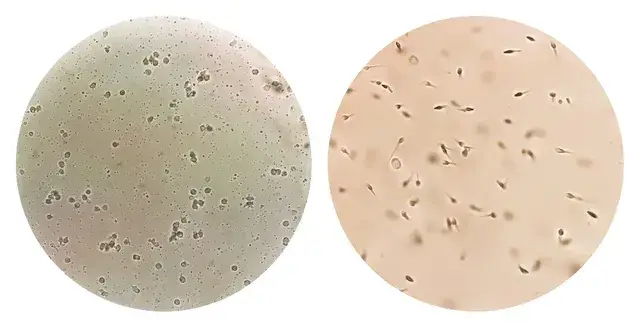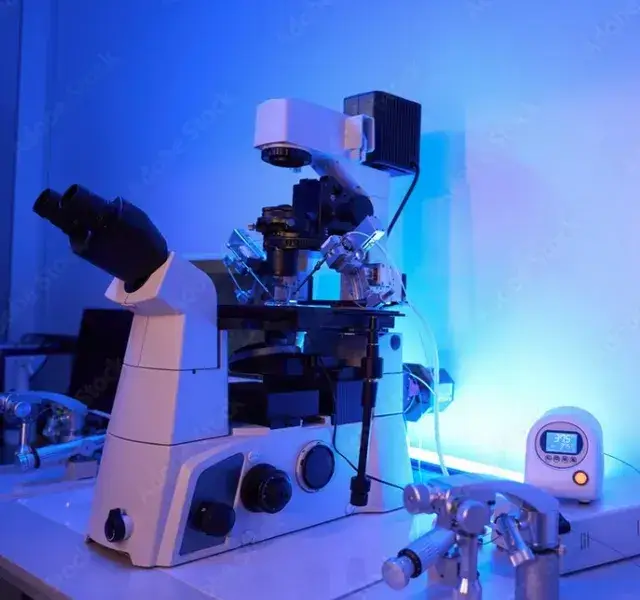Hope Beyond Azoospermia: Discovering Hidden Sperm
Being informed that your semen analysis shows no sperm can be a distressing experience. For men diagnosed with azoospermia, this diagnosis can create uncertainty about their ability to conceive a biological child. However, modern reproductive science offers Extended Sperm Search (ESS)—an advanced technique designed to detect sperm that may be missed in routine semen analyses.
At New York Cryo and the Men’s Fertility Laboratory, we specialize in ESS, providing a non-invasive alternative to surgical sperm retrieval for men with non-obstructive azoospermia (NOA) and other severe male fertility issues.
Understanding Azoospermia and Non-Obstructive Azoospermia (NOA)
What is Azoospermia?
Azoospermia is a condition where no sperm is detected in a man’s ejaculate. Affecting 1% of all men and contributing to 10-15% of male infertility cases, it is a leading cause of infertility. There are two main types:
Obstructive Azoospermia (OA): Sperm production is normal, but a blockage in the reproductive tract prevents sperm from reaching the ejaculate.
Non-Obstructive Azoospermia (NOA): The testicles produce few or no sperm due to hormonal imbalances, genetic conditions, testicular failure, or environmental factors.
Even in NOA, some sperm may still be present in the semen, albeit in extremely low concentrations. ESS is designed to find these sperm, providing a chance for biological fatherhood.
What is Extended Sperm Search (ESS)?
A Revolutionary Approach to Male Infertility
ESS is an advanced laboratory technique that meticulously examines an entire semen sample under high-powered microscopy to identify rare, viable sperm. Unlike standard semen analysis, which evaluates only a fraction of the sample, ESS significantly improves the chances of finding sperm that may have been previously undetected.
How Does ESS Work?
ESS involves a comprehensive, step-by-step process to maximize sperm detection:
Step 1: Sample Preparation
The semen sample is collected and allowed to liquefy at room temperature for 20–30 minutes.
The sample undergoes density gradient centrifugation, which separates sperm from debris and seminal plasma.
Step 2: High-Magnification Microscopy
Traditional semen analysis uses only 200x-400x magnification; ESS additioanlly employs 600x-1000x magnification using phase-contrast microscopes.
The entire sample volume is examined systematically to ensure no sperm go undetected.
Step 3: Systematic Search & Documentation
Grid-based scanning techniques ensure a thorough examination of all sample sections.
Any detected sperm are documented and photographed.
Viability testing may be conducted to differentiate live from non-viable sperm.
Step 4: Discussion of Findings & Treatment Options
The findings of ESS are discussed with the patient and their partner.
The physician presents all available options, including:
A second ESS Procedure with cryopreservation of any sperm found for future use in intracytoplasmic sperm injection (ICSI).
Surgical sperm retrieval options, such as Testicular Sperm Extraction (TESE) or Micro-TESE.
The benefits, success rates, risks, and costs of each approach are explained in detail.
Understanding the partner’s reproductive health is also critical, as it may influence the choice of treatment.
This step ensures that the patient and their partner make an informed decision before proceeding with ESS and cryopreservation or surgical retrieval.
Step 5: Sperm Collection & Cryopreservation
If sperm are found by our diagnostic ESS we will discuss obtaining a second specimen for ESS plus cryopreservation for future use in intracytoplasmic sperm injection (ICSI), avoiding the need for surgical sperm retrieval. We do not presently offer this option and we will refer you to a center that does.
Cryopreservation would be performed on a separate semen specimen undergoing ESS.
Cryopreservation ensures that viable sperm are available for use in future fertility treatments without requiring additional retrieval attempts.
Who Should Consider ESS?
1. Men Diagnosed with Non-Obstructive Azoospermia (NOA)
If standard semen analysis detects no sperm, ESS may identify rare sperm that were missed.
Men with NOA who produce small numbers of sperm in the testes may occasionally release sperm into the ejaculate, detectable via ESS.
2. Men Seeking to Avoid Surgical Sperm Retrieval
Testicular Sperm Extraction (TESE) and Micro-TESE are commonly used for sperm retrieval in NOA cases but involve anesthesia, pain, and potential testicular damage.
ESS should always be attempted first to determine if sperm are present in the ejaculate before resorting to invasive procedures.
3. Men with Cryptozoospermia
Cryptozoospermia refers to cases where extremely low sperm concentrations are present but not detected in routine semen analysis.
ESS enhances detection and can increase the chances of a successful fertility treatment.
4. Cancer Patients Seeking Fertility Preservation
Men undergoing chemotherapy or radiation therapy may experience a severe reduction in sperm production.
ESS can help detect sperm in pre-treatment semen samples, increasing options for fertility preservation.
Why Choose ESS? The Benefits
✅ Non-Invasive Alternative: Avoids surgical sperm retrieval procedures.
✅ Increases Detection Rates: Locates rare sperm overlooked in traditional analysis.
✅ Higher IVF/ICSI Success: Finding sperm in ejaculate simplifies assisted reproduction.
✅ Immediate Cryopreservation: If sperm are found, they can be preserved for future use.
✅ Cost-Effective: Reduces the need for multiple invasive procedures.
What to Expect During an ESS Evaluation
🔹 Step 1: Sample Collection – Patients provide a semen sample through masturbation in a sterile laboratory setting.
🔹 Step 2: ESS Analysis – The sample undergoes intensive scanning and analysis by trained laboratory professionals.
🔹 Step 3: Results & Consultation – Results are typically available within a few days to a week. If sperm are found, a fertility specialist will discuss treatment options, including ICSI or sperm freezing.
Take the Next Step Toward Parenthood
For men diagnosed with non-obstructive azoospermia, a “no sperm found” result does not necessarily mean there is no hope. Extended Sperm Search (ESS) offers a powerful, non-invasive option for detecting rare sperm, providing the opportunity for biological fatherhood without the need for surgical intervention.
If you have been diagnosed with azoospermia and are exploring fertility options, talk to your urologist or reproductive specialist about ESS. This could be the missing link in your fertility journey, offering new possibilities for parenthood through assisted reproductive technologies (ART).
📞 For more information or to schedule an Extended Sperm Search (ESS) evaluation, contact us at:
🌐 516-487-2700
📩 info@nycryo.com
Your Future Starts Here
Take control of your fertility options with the latest advances in reproductive medicine. Extended Sperm Search can change your story.


